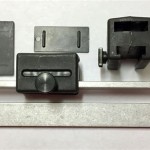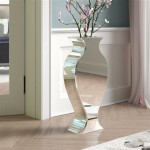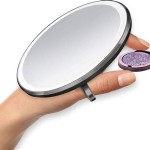Mirror Hanging Design: A Comprehensive Guide
Mirror hanging design transcends mere functionality, evolving into a pivotal element of interior aesthetics. The strategic placement and style of a mirror can dramatically alter the perception of space, enhance lighting, and serve as a focal point that ties a room together. This article delves into the various aspects of mirror hanging design, providing a comprehensive guide to selecting, positioning, and installing mirrors to achieve optimal visual impact.
The selection process is paramount and should be approached with careful consideration of the room's dimensions, natural light sources, existing décor, and desired aesthetic. A mirror that is too small can appear insignificant, while one that is too large can overwhelm the space. Similarly, the frame style should complement the room’s overall design scheme, whether it leans towards modern minimalism, traditional elegance, or rustic charm. Improper placement can diminish the mirror’s potential, leading to awkward reflections or insufficient light distribution.
Furthermore, safety is of utmost importance during the installation phase. Ensuring the mirror is securely mounted to the wall, using appropriate hardware for the wall type and mirror weight, prevents potential accidents and damage. This guide will explore these aspects in detail, providing practical advice and considerations for implementing effective mirror hanging designs.
Key Point 1: Selecting the Right Mirror
The first step in effective mirror hanging design is choosing a mirror that complements the space and desired aesthetic. This involves considering the mirror's size, shape, frame, and style.
Size and Shape: The size of the mirror should be proportionate to the wall on which it will be hung. As a general rule, consider the amount of wall space available and the furniture or architectural features surrounding it. A mirror placed above a console table, for instance, should be approximately two-thirds the width of the table. The shape of the mirror can influence the room's geometry. A rectangular or square mirror can create a sense of height and formality, while a round or oval mirror can soften the lines of a room and add a touch of elegance.
Frame Style: The frame is an integral part of the mirror's overall design. Consider the existing décor and architectural style of the room when selecting a frame. A minimalist frame with clean lines is suitable for modern interiors. Ornate, gilded frames are appropriate for traditional or classic settings. A rustic wooden frame can complement farmhouse or country-style décor. The frame's material, color, and texture should harmonize with the surrounding elements.
Mirror Style: Beyond the frame, the style of the mirror itself plays a role. Beveled edges can add a touch of sophistication and reflect light in an interesting way. Antique mirrors with distressed finishes can create a vintage or aged aesthetic. Consider the type of glass used, as some mirrors may have a slight tint or reflective quality that impacts the overall look.
Functionality: The intended function of the mirror should also factor into the selection process. Mirrors in bathrooms typically require moisture-resistant frames and may be equipped with features like built-in lighting or defogging technology. Mirrors in entryways may prioritize functionality and a full-length view. Decorative mirrors in living rooms or bedrooms may focus more on aesthetic appeal.
Ultimately, selecting the right mirror involves a careful assessment of the room's dimensions, style, and intended purpose. By considering these factors, one can choose a mirror that enhances the space and reflects personal taste.
Key Point 2: Strategic Mirror Placement
The placement of a mirror is as important as its design. Strategic placement can maximize its impact on light, space, and visual interest. Several factors should be considered when determining the optimal location for a mirror.
Light Reflection: Mirrors are excellent at reflecting light, making them ideal for brightening dark rooms or hallways. Place the mirror opposite or adjacent to a window to maximize the amount of natural light reflected into the space. Consider the angle of the light and how it will be reflected at different times of day. Avoid placing mirrors where they will reflect harsh sunlight directly into the eyes.
Space Illusion: Mirrors can create the illusion of larger spaces, making them particularly useful in small rooms. A large mirror placed on a wall can visually double the size of the room. In narrow hallways, a mirror can create a sense of width and openness. Consider the reflections created by the mirror and ensure they are aesthetically pleasing and do not create a disorienting effect.
Focal Point Creation: Mirrors can serve as focal points in a room, drawing the eye and adding visual interest. Position the mirror above a fireplace, console table, or other prominent feature to create a focal point. Consider the objects that will be reflected in the mirror and ensure they are visually appealing. A mirror can also be used to highlight artwork or architectural details.
Avoiding Unwanted Reflections: Careful attention should be paid to the objects and scenes reflected in the mirror. Avoid placing mirrors where they will reflect cluttered areas or unsightly views. Consider the privacy of the space and ensure the mirror does not inadvertently reflect into neighboring rooms or outdoor areas. Poor placement can detract from the room's aesthetics and create a sense of unease.
Mirror Height: The height at which a mirror is hung is also crucial. In general, the center of the mirror should be at eye level. This ensures that people can easily see their reflection and that the mirror is visually balanced on the wall. Adjust the height as needed based on the height of the ceiling and the surrounding furniture.
By carefully considering these factors, one can strategically place mirrors to maximize their impact on light, space, and visual appeal. Proper placement can transform a room, creating a more inviting and aesthetically pleasing environment.
Key Point 3: Secure and Safe Installation
Once the mirror has been selected and the placement determined, the final step is installation. Secure and safe installation is paramount to preventing accidents and ensuring the longevity of the mirror. Proper preparation and hardware selection are essential for a successful installation.
Wall Type Assessment: The type of wall on which the mirror will be hung is a critical factor in determining the appropriate hardware. Drywall, plaster, brick, and concrete walls each require different types of anchors and fasteners. Determine the wall type before purchasing any hardware. Using the wrong type of hardware can result in the mirror falling off the wall or causing damage to the wall itself.
Weight Calculation: It is crucial to accurately assess the weight of the mirror to select the appropriate hardware. The weight of the mirror will determine the size and strength of the anchors and fasteners required. Exceeding the weight capacity of the hardware can lead to failure and potential accidents. Use a scale to accurately weigh the mirror before beginning the installation process.
Hardware Selection: Choose hardware specifically designed for hanging mirrors. This typically includes D-rings, wire, hooks, and anchors. D-rings should be securely attached to the back of the mirror frame. The wire should be strong enough to support the mirror's weight. Hooks should be appropriately sized for the wire and capable of supporting the load. Anchors should be selected based on the wall type and weight of the mirror. Consult a hardware professional for guidance on selecting the appropriate hardware for your specific situation.
Installation Techniques: Use a level to ensure the mirror is hung straight. Mark the location of the mounting holes on the wall using a pencil. Drill pilot holes into the wall at the marked locations. Insert the anchors into the pilot holes. Attach the hooks to the anchors. Hang the mirror on the hooks, ensuring it is securely supported. Double-check the level and make any necessary adjustments.
Safety Precautions: Wear safety glasses and gloves during the installation process to protect your eyes and hands. Use a stud finder to locate wall studs and avoid drilling into electrical wires or plumbing pipes. If you are unsure about any aspect of the installation process, consult a professional installer. Attempting to install a mirror without the proper knowledge and tools can be dangerous.
By following these guidelines, one can ensure that the mirror is securely and safely installed. Proper installation is essential for the longevity of the mirror and the safety of those around it. A well-installed mirror will provide years of enjoyment and enhance the aesthetics of the space.
In conclusion, mirror hanging design requires meticulous planning, careful selection, strategic placement, and secure installation. Paying attention to these details will result in a mirror that enhances the aesthetics of the space, reflects light effectively, and provides a sense of visual balance.

Macrame Wall Hanging Mirror Mm31 Wisholize

Multi Utility Handmade Marigold Design Hanging Mirror With Blue Pottery Tiles And Hooks Get Your Custom Size Made

Hanging Mirror With Rope For Modern Contemporary Decor Mohh

Beaded Vertical Mirror Wall Hangings With Tiny Ringing Bells Bandhej Side Door Hangers N Boho Home Decor Ethnic Wedding Decorations Hanging Beads

Rounded Rectangular Hanging Rod Mirror Hotel Bathroom Homestay Luminous China Frame Glass Modern Made In Com

Objects Of Design 341 Round Hanging Mirror Mad About The House

Diy Wall Hanging Mirror Decoration Room Decor Art With Creativity

Tiny Hanging Wall Mirror Decor Bedroom

51 Mirror Decoration Ideas To Brighten Your Space

Bohemian Handmade Woven Wall Mirror Acrylic Temu








